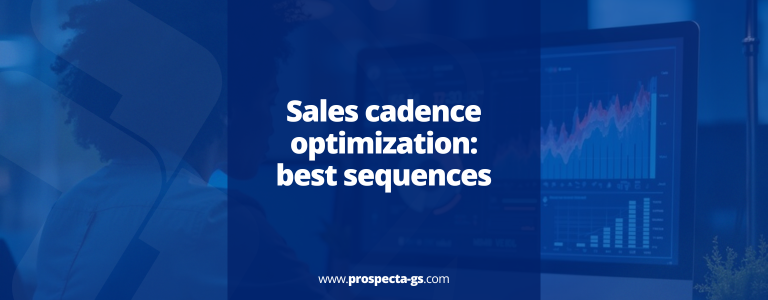Sales Cadence Optimization: best sequences
Outbound prospecting is no longer about who shouts the loudest, it’s about who follows up with precision. In today’s competitive B2B landscape, an optimized sales cadence can be the difference between pipeline growth and radio silence.
Whether you’re running a high-performance in-house team or leveraging an outsourced SDR model, the key to results lies in timing, persistence, and multi-channel execution.
Let’s explore how modern B2B tech companies can optimize their sales cadence, and we’ll even give you a proven 10-day example you can use or adapt immediately.
What is a sales cadence?
A sales cadence is a predefined sequence of touchpoints (emails, calls, LinkedIn messages, etc.) used to contact a prospect over a period of time. It’s designed to create engagement, build rapport, and convert a cold contact into a sales opportunity.
A poor cadence = wasted opportunities.
A smart cadence = consistent meetings on your calendar.
Why sales cadence matters more than ever
Inboxes are flooded. Phone calls are screened. Buyers are skeptical. But the right cadence still cuts through the noise. According to Gartner, the average B2B decision journey involves 6–10 decision-makers and nearly 60% of the process is completed before a rep is even contacted.
That means your cadence isn’t just about follow-ups, it’s about preempting objections, earning trust, and delivering value across channels.
Key elements of a high-converting sales cadence
A modern sales cadence should include:
Multi-channel outreach: Email, phone, LinkedIn, voicemail, WhatsApp (where appropriate).
Personalization: At least 30% of your message tailored to the recipient.
Time-based logic: Appropriate spacing between touchpoints to avoid spammy behavior.
Consistency: A fixed number of touches across a clear timeframe.
Adaptability: Able to shift based on responses or signals of interest.
The perfect 10-day sales cadence for B2B tech
Here’s a 10-day sales cadence for B2B tech companies targeting mid-market and enterprise prospects:
Day | Channel | Action | Notes |
|---|---|---|---|
1 | Email | Intro email + pain-based hook | Focus on pain point and value offered |
2 | LinkedIn | Connection request | No pitch, just context and relevance |
3 | Call | First cold call attempt | Leave voicemail if no answer |
4 | Email | Case study or relevant insight | Build trust with proof |
5 | LinkedIn | Engage with a post or comment | Soft touch for visibility |
6 | Call | Second call with new angle | Refer to previous email or LinkedIn |
7 | Email | “Breakup-style” email with CTA | Include calendar link |
8 | WhatsApp/SMS | Short message if phone verified | Legal and appropriate |
10 | Call | Final voicemail (personal tone) | Humanize, show persistence |
Key Notes:
All emails should have short subject lines (<50 characters) and end with a soft CTA (e.g., “Would it make sense to talk?”).
Calls should aim for value-first conversation, not immediate pitching.
LinkedIn interactions help warm up future emails and show relevance.
Sales cadence mistakes to avoid
❌ Using only one channel (e.g., email)
❌ Sending templated messages without context
❌ Giving up after 2–3 touches
❌ Failing to track replies and adapt
❌ Not segmenting cadence by persona or buying stage
Benefits of an optimized sales cadence
Higher response rates
More qualified meetings
Shorter sales cycles
Better SDR performance tracking
Stronger brand impression
How to build your own cadence (or let experts handle it)
If you’re managing internal SDRs, start by mapping your buyer journey. Then, build cadences that match each stage, from cold outreach to warm reactivation. Test relentlessly, but always follow a structured playbook.
Alternatively, companies like Prospecta Global Solutions specialize in outsourced SDR services that include ready-to-deploy cadences, tailored by industry, persona, and buying intent, all backed by guaranteed performance SLAs.
FAQ
What is the ideal number of touches in a sales cadence?
Most high-performing cadences include 8–12 touchpoints over 10–15 days, mixing channels to avoid fatigue and increase visibility.
How long should a sales cadence last?
In B2B tech, 10–15 business days is optimal. Longer cadences may work for enterprise deals, while shorter ones are better for SMBs.
Is cold calling still relevant in sales cadence?
Yes, when used strategically. Cold calls perform best when paired with warm-up touches like email and LinkedIn.
What’s the role of automation in sales cadence?
Automation tools help scale and track cadences but must be balanced with personalization to maintain effectiveness.
Success in outbound isn’t about more activity, it’s about smart, strategic sequences. A well-crafted sales cadence builds momentum, opens doors, and shortens sales cycles.
If you’re serious about scaling pipeline with predictable, high-converting outreach, we’re here to help.


